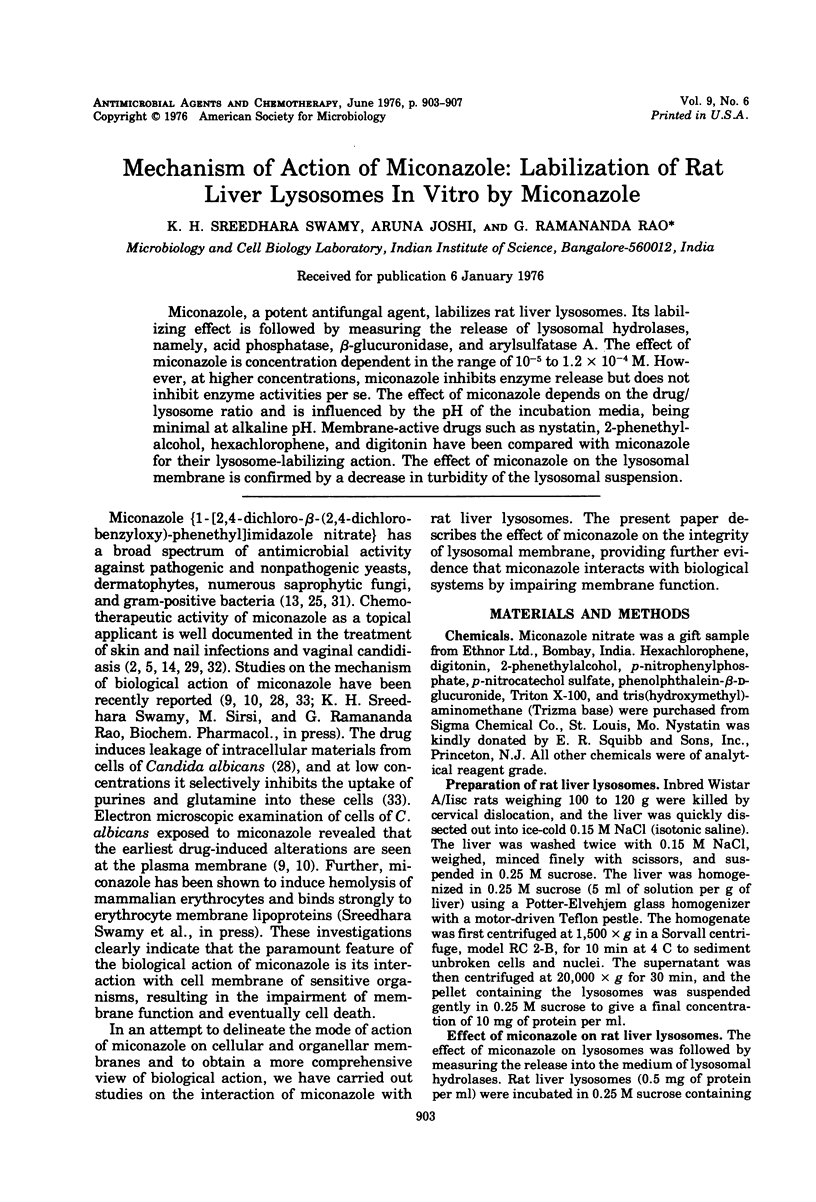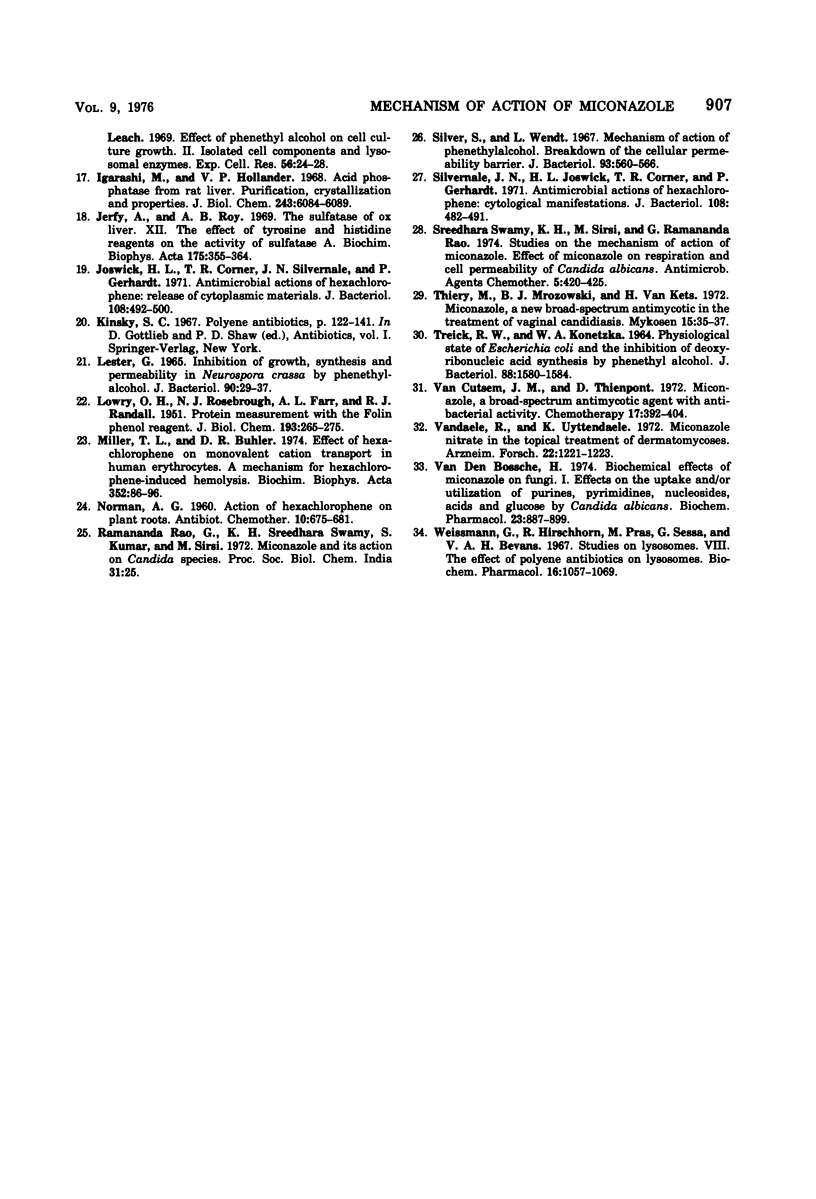Abstract
Miconazole, a potent antifungal agent, labilizes rat liver lysosomes. Its labilizing effect is followed by measuring the release of lysosomal hydrolases, namely, acid phosphatase, β-glucuronidase, and arylsulfatase A. The effect of miconazole is concentration dependent in the range of 10−5 to 1.2 × 10−4 M. However, at higher concentrations, miconazole inhibits enzyme release but does not inhibit enzyme activities per se. The effect of miconazole depends on the drug/lysosome ratio and is influenced by the pH of the incubation media, being minimal at alkaline pH. Membrane-active drugs such as nystatin, 2-phenethyl-alcohol, hexachlorophene, and digitonin have been compared with miconazole for their lysosome-labilizing action. The effect of miconazole on the lysosomal membrane is confirmed by a decrease in turbidity of the lysosomal suspension.
Full text
PDF




Selected References
These references are in PubMed. This may not be the complete list of references from this article.
- Assa Y., Shany S., Gestetner B., Tencer Y., Birk Y., Bondi A. Interaction of alfalfa saponins with components of the erythrocyte membrane in hemolysis. Biochim Biophys Acta. 1973 Apr 25;307(1):83–91. doi: 10.1016/0005-2736(73)90027-8. [DOI] [PubMed] [Google Scholar]
- Botter A. A. Topical treatment of nail and skin infections with miconazole, a new broad-spectrum antimycotic. Mykosen. 1971 Apr 1;14(4):187–191. doi: 10.1111/j.1439-0507.1971.tb03028.x. [DOI] [PubMed] [Google Scholar]
- Brossmer R., Bohn B. Chemical and physico-chemical alterations of human erythrocytes by periodate, succinic anhydride, 2-phenylethanol, and 1,1-dimethylphenylethanol: effects on membrane permeability and on metabolism of intact cells and hemolysates. FEBS Lett. 1974 May 15;42(1):116–118. doi: 10.1016/0014-5793(74)80293-0. [DOI] [PubMed] [Google Scholar]
- Brossmer R., Bohn B., Schlicker H. Influence of 2-phenylethanol and 1,1'-dimethylphenylethanol on metabolic activity and cell membrane function in Ehrlich ascites tumour cells. FEBS Lett. 1973 Sep 15;35(2):191–194. doi: 10.1016/0014-5793(73)80281-9. [DOI] [PubMed] [Google Scholar]
- Brugmans J. P., Van Cutsem J. M., Thienpont D. C. Treatment of long-term tinea pedis with miconazole. Double-blind clinical evaluation. Arch Dermatol. 1970 Oct;102(4):428–432. [PubMed] [Google Scholar]
- Burns V. W. Microviscosity and calcium exchange in yeast cells and effects of phenethyl alcohol. Exp Cell Res. 1971 Jan;64(1):35–40. doi: 10.1016/0014-4827(71)90189-3. [DOI] [PubMed] [Google Scholar]
- Corner T. R. Hemolysis by hexachlorophene. Chem Biol Interact. 1974 Feb;8(2):107–111. doi: 10.1016/0009-2797(74)90056-8. [DOI] [PubMed] [Google Scholar]
- Corner T. R., Joswick H. L., Silvernale J. N., Gerhardt P. Antimicrobial actions of hexachlorophene: lysis and fixation of bacterial protoplasts. J Bacteriol. 1971 Oct;108(1):501–507. doi: 10.1128/jb.108.1.501-507.1971. [DOI] [PMC free article] [PubMed] [Google Scholar]
- DOURMASHKIN R. R., DOUGHERTY R. M., HARRIS R. J. Electron microscopic observations on Rous sarcoma virus and cell membranes. Nature. 1962 Jun 23;194:1116–1119. doi: 10.1038/1941116a0. [DOI] [PubMed] [Google Scholar]
- De Nollin S., Borgers M. Scanning electron microscopy of Candida albicans after in vitro treatment with miconazole. Antimicrob Agents Chemother. 1975 May;7(5):704–711. doi: 10.1128/aac.7.5.704. [DOI] [PMC free article] [PubMed] [Google Scholar]
- De Nollin S., Borgers M. The ultrastructure of Candida albicans after in vitro treatment with miconazole. Sabouraudia. 1974 Nov;12(3):341–351. [PubMed] [Google Scholar]
- Flores G., Buhler D. R. Hemolytic properties of hexachlorophene and related chlorinated bisphenols. Biochem Pharmacol. 1974 Jul 1;23(13):1835–1843. doi: 10.1016/0006-2952(74)90192-0. [DOI] [PubMed] [Google Scholar]
- Godefroi E. F., Heeres J., Van Cutsem J., Janssen P. A. The preparation and antimycotic properties of derivatives of 1-phenethylimidazole. J Med Chem. 1969 Sep;12(5):784–791. doi: 10.1021/jm00305a014. [DOI] [PubMed] [Google Scholar]
- Hamilton-Miller J. M. Chemistry and biology of the polyene macrolide antibiotics. Bacteriol Rev. 1973 Sep;37(3):166–196. [PMC free article] [PubMed] [Google Scholar]
- Higgins M. L., Shaw T. J., Tillman M. C., Leach F. R. Effect of phenethyl alcohol on cell culture growth. II. Isolated cell components and lysosomal enzymes. Exp Cell Res. 1969 Jul;56(1):24–28. doi: 10.1016/0014-4827(69)90387-5. [DOI] [PubMed] [Google Scholar]
- Igarashi M., Hollander V. P. Acid phosphatase from rat liver. Purification, crystallization, and properties. J Biol Chem. 1968 Dec 10;243(23):6084–6089. [PubMed] [Google Scholar]
- Jerfy A., Roy A. B. The sulphatase of ox liver. XII. The effect of tyrosine and histidine reagents on the activity of sulphatase A. Biochim Biophys Acta. 1969 Mar;175(2):355–364. doi: 10.1016/0005-2795(69)90013-0. [DOI] [PubMed] [Google Scholar]
- Joswick H. L., Corner T. R., Silvernale J. N., Gerhardt P. Antimicrobial actions of hexachlorophene: release of cytoplasmic materials. J Bacteriol. 1971 Oct;108(1):492–500. doi: 10.1128/jb.108.1.492-500.1971. [DOI] [PMC free article] [PubMed] [Google Scholar]
- LOWRY O. H., ROSEBROUGH N. J., FARR A. L., RANDALL R. J. Protein measurement with the Folin phenol reagent. J Biol Chem. 1951 Nov;193(1):265–275. [PubMed] [Google Scholar]
- Lester G. Inhibition of Growth, Synthesis, and Permeability in Neurospora crassa by Phenethyl Alcohol. J Bacteriol. 1965 Jul;90(1):29–37. doi: 10.1128/jb.90.1.29-37.1965. [DOI] [PMC free article] [PubMed] [Google Scholar]
- Miller T. L., Buhler D. R. Effect of hexachlorophene on monovalent cation transport in human erythrocytes. A mechanism for hexachlorophene-induced hemolysis. Biochim Biophys Acta. 1974 May 30;352(1):86–96. doi: 10.1016/0005-2736(74)90181-3. [DOI] [PubMed] [Google Scholar]
- NORMAN A. G. Action of hexachlorophene on plant roots. Antibiot Chemother. 1960 Nov;10:675–681. [PubMed] [Google Scholar]
- Silver S., Wendt L. Mechanism of action of phenethyl alcohol: breakdown of the cellular permeability barrier. J Bacteriol. 1967 Feb;93(2):560–566. doi: 10.1128/jb.93.2.560-566.1967. [DOI] [PMC free article] [PubMed] [Google Scholar]
- Silvernale J. N., Joswick H. L., Corner T. R., Gerhardt P. Antimicrobial actions of hexachlorophene: cytological manifestations. J Bacteriol. 1971 Oct;108(1):482–491. doi: 10.1128/jb.108.1.482-491.1971. [DOI] [PMC free article] [PubMed] [Google Scholar]
- TREICK R. W., KONETZKA W. A. PHYSIOLOGICAL STATE OF ESCHERICHIA COLI AND THE INHIBITION OF DEOXYRIBONUCLEIC ACID SYNTHESIS BY PHENETHYL ALCOHOL. J Bacteriol. 1964 Dec;88:1580–1584. doi: 10.1128/jb.88.6.1580-1584.1964. [DOI] [PMC free article] [PubMed] [Google Scholar]
- Thiery M., Mrozowski B. J., Van Kets H. Miconazole, a new broad-spectrum antimycotic, in the treatment of vaginal candidosis. Mykosen. 1972 Jan 1;15(1):35–37. doi: 10.1111/j.1439-0507.1972.tb02425.x. [DOI] [PubMed] [Google Scholar]
- Van Cutsem J. M., Thienpont D. Miconazole, a broad-spectrum antimycotic agent with antibacterial activity. Chemotherapy. 1972;17(6):392–404. doi: 10.1159/000220875. [DOI] [PubMed] [Google Scholar]
- Van den Bossche H. Biochemical effects of miconazole on fungi. I. Effects on the uptake and or utilization of purines, pyrimidines, nucleosides, amino acids and glucose by Candida albicans. Biochem Pharmacol. 1974 Feb 15;23(4):887–899. doi: 10.1016/0006-2952(74)90220-2. [DOI] [PubMed] [Google Scholar]
- Vandaele R., Uyttendaele K. Miconazole nitrate in the topical treatment of dermatomycoses. A clinical evaluation. Arzneimittelforschung. 1972 Jul;22(7):1221–1223. [PubMed] [Google Scholar]
- Weissmann G., Hirschhorn R., Pras M., Sessa G., Bevans V. A. Studies of lysosomes. 8. The effect of polyene antibiotics on lysosomes. Biochem Pharmacol. 1967 Jun;16(6):1057–1069. doi: 10.1016/0006-2952(67)90279-1. [DOI] [PubMed] [Google Scholar]


